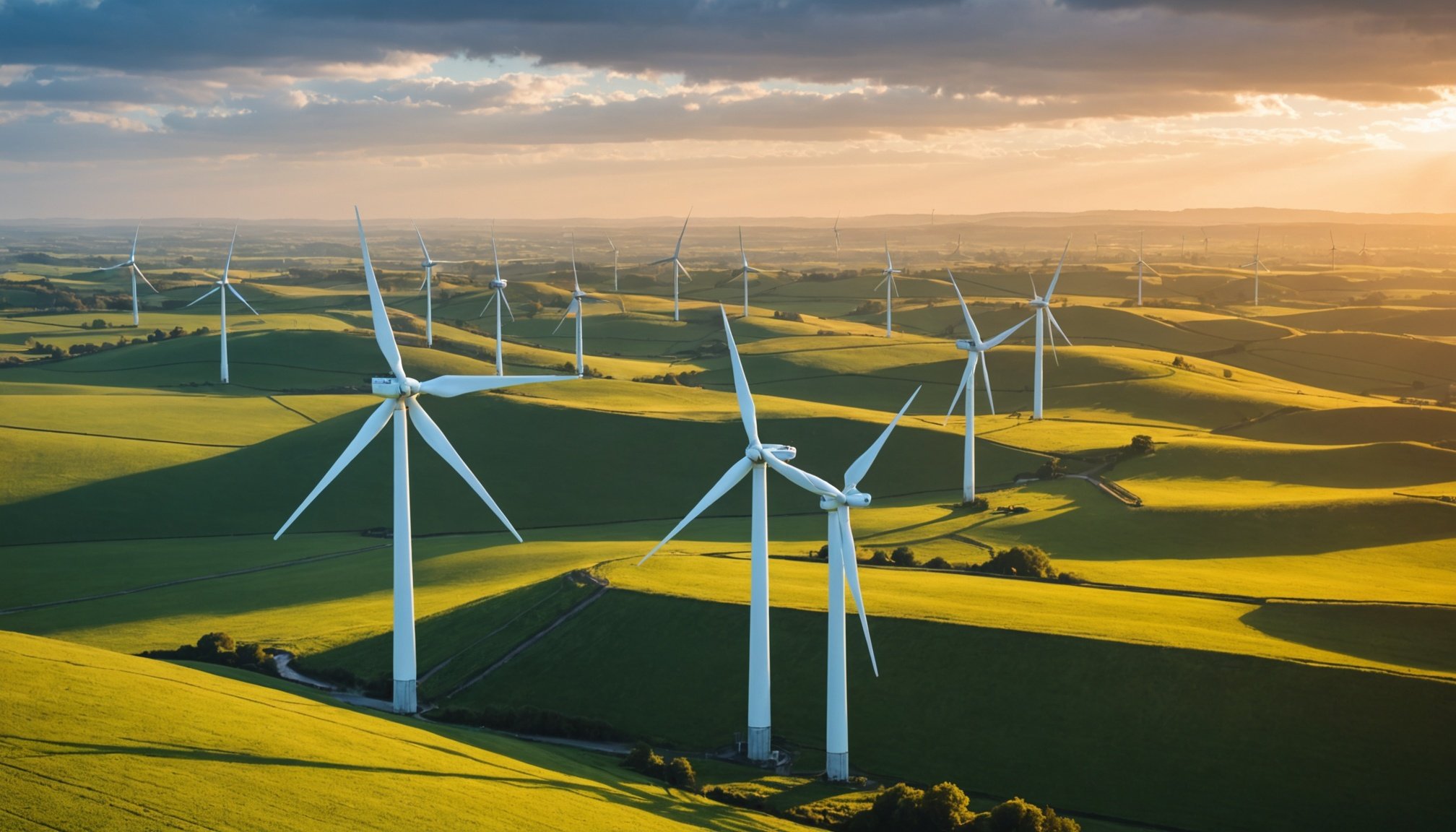Revolutionizing Wind Energy: How AI is Enhancing Renewable Power in the UK
The UK is at the forefront of a revolutionary shift in the energy sector, driven by the integration of artificial intelligence (AI) into wind energy systems. This transformation is not only enhancing the efficiency and sustainability of renewable power but also paving the way for a more resilient and reliable energy grid.
Optimizing Energy Production with AI
AI is transforming the way wind energy is produced, making it more efficient and predictable. One of the key areas where AI is making a significant impact is in the optimization of wind turbine performance.
Also to discover : Mastering Project Management: UK IT Firms’ Ultimate Guide to Harnessing Agile Success
Real-Time Adjustments
Smart algorithms can adjust solar panel angles or wind turbine blades in real time to maximize energy output. For instance, AI-enabled systems can continuously monitor and adjust the angle and pitch of wind turbine blades to capture the maximum amount of wind energy, even in varying wind conditions. This real-time optimization is crucial for enhancing grid stability and reducing operational costs. According to the National Energy System Operator (NESO), integrating machine learning models has improved solar forecasting by 33%, which is a significant step towards more efficient energy production[1].
Predictive Maintenance
Predictive maintenance is another area where AI is revolutionizing wind energy. The partnership between NKE FERSA and Nanoprecise is a prime example of this. Their Condition Monitoring System uses a 6-in-1 wireless sensor and an AI-driven cloud-based platform to monitor critical parameters such as vibration, temperature, and magnetic flux in wind turbines. This system provides predictive maintenance information, allowing operators to detect potential issues before they impact energy production. As Sunil Vedula, Founder and CEO of Nanoprecise, noted, “Bearing faults are responsible for the majority of wind turbine’s planetary gearbox downtime. With our patented wavelet neural network enabled algorithms, we are able to diagnose faults on individual components in a gearbox,” significantly reducing downtime and increasing the availability of wind turbines[2].
In the same genre : Maximizing Route Efficiency: Cutting-Edge AI and Machine Learning Tactics for UK Logistics Firms
AI-Designed Wind Turbines for Urban Environments
Traditional wind turbines are often optimized for high wind speeds found in open fields, but urban environments present unique challenges with lower wind speeds and turbulence. Here, AI is stepping in to design wind turbines tailored to these specific conditions.
Geographically Optimized Turbines
Researchers at the University of Birmingham, in collaboration with AI design specialists EvoPhase and precision metal fabricators Kwik Fab Ltd, have developed the world’s first AI-designed, geographically optimized wind turbine. This turbine is designed to capture the relatively low wind speeds in urban areas like Birmingham, UK, and manage the turbulence caused by surrounding buildings. The AI-driven approach allowed the team to generate, test, and refine over 2,000 designs in just weeks, resulting in a turbine that is up to seven times more efficient than existing designs in urban settings[3].
Enhancing ROI Predictability and Market Insights
AI is not only improving the technical aspects of wind energy but also enhancing the financial and strategic decision-making processes.
Improving ROI Predictability
AI can significantly refine wind studies and reduce construction cost overruns, making wind farm investments more predictable. By training machine learning models on extensive data on wind prediction and construction, companies can achieve more accurate algorithms for these predictions. This approach helps reduce the risk of underperforming wind farms and avoids costly investments in unsuitable locations. As outlined in the strategy for integrating AI into wind energy operations, using AI can increase margins by up to 20 percent if all projects meet planned expectations[4].
Market Volatility and Electricity Trading
AI also provides valuable insights into market volatility, aiding in strategic electricity trading decisions. Market pricing models, such as MarketWatch™, can estimate electricity market pricing, helping companies make informed trading decisions. By analyzing extensive data sets from past projects, AI can enhance wind-prediction models, leading to more reliable predictions of kilowatt-hour output and better market positioning[4].
Overcoming Technical and Regulatory Barriers
While AI offers numerous benefits, its adoption in the energy sector is not without challenges.
Infrastructural Barriers
The UK’s aging grid infrastructure and data silos pose significant challenges to the widespread adoption of AI. Comprehensive investments in digital infrastructure and data-sharing mechanisms are essential. Initiatives like NESO’s “Data Sharing Infrastructure” aim to create centralized access to critical datasets for energy operators and innovators, addressing these gaps[1].
Regulatory and Ethical Considerations
The high computing demands of AI systems and the ethical concerns surrounding AI decision-making are critical issues. Ensuring transparent AI implementation and addressing privacy risks and potential biases are paramount. Regulatory frameworks must evolve to accommodate AI’s rapid advancement while maintaining security and fairness. The UK government’s initiatives, such as the Department of Energy and Net Zero’s commitment to decarbonizing the electricity grid by 2030, provide a strategic foundation for integrating AI responsibly[1].
Practical Insights and Actionable Advice
For those looking to leverage AI in the wind energy sector, here are some practical insights and actionable advice:
Key Areas for AI Implementation
- Predictive Maintenance: Implement AI-based condition monitoring systems to reduce downtime and extend the lifespan of wind turbines.
- Energy Production Optimization: Use AI to adjust wind turbine blades and solar panel angles in real time to maximize energy output.
- Market Insights: Utilize AI to enhance wind-prediction models and gain insights into market volatility for better trading decisions.
Investment in Digital Infrastructure
- Invest in digital infrastructure to overcome data silos and ensure comprehensive data sharing.
- Support initiatives like NESO’s “Data Sharing Infrastructure” to create centralized access to critical datasets.
Ethical and Regulatory Compliance
- Ensure transparent AI implementation and address ethical concerns such as privacy risks and potential biases.
- Advocate for explainable and contestable AI models to foster trust and accountability.
Table: Benefits of AI in Wind Energy
| Benefit | Description | Impact |
|---|---|---|
| Predictive Maintenance | AI-based condition monitoring to detect potential issues before they impact energy production. | Reduced downtime, extended equipment lifespan, and lower maintenance costs[2]. |
| Energy Production Optimization | Real-time adjustments to wind turbine blades and solar panel angles to maximize energy output. | Enhanced grid stability, reduced operational costs, and increased energy production[1]. |
| Improved ROI Predictability | AI-refined wind studies and reduced construction cost overruns. | Increased margins by up to 20 percent if all projects meet planned expectations[4]. |
| Market Insights | AI-enhanced wind-prediction models and market volatility analysis. | Better trading decisions, more reliable predictions of kilowatt-hour output, and improved market positioning[4]. |
| Geographically Optimized Turbines | AI-designed wind turbines tailored to specific urban environments. | Up to seven times more efficient than existing designs in urban settings[3]. |
AI is not just a tool but a transformative force in the wind energy sector. By optimizing existing systems, unlocking new efficiencies, and addressing technical and regulatory challenges, AI is supporting the UK’s transition to a cleaner, more resilient energy landscape. As the industry continues to evolve, the collaboration between industry, government, and academia will be crucial to realizing AI’s full potential.
In the words of Leonard Nicusan, Chief Technology Officer of EvoPhase, “Using AI was essential for breaking free from the long-standing biases that have influenced turbine designs for the past century. AI allowed us to explore design possibilities beyond the scope of traditional human experimentation.”[3]
As we look to the future, it is clear that AI will play a pivotal role in shaping the energy sector. By embracing these technologies and addressing the challenges they present, we can create a more sustainable, efficient, and reliable energy system for generations to come.











